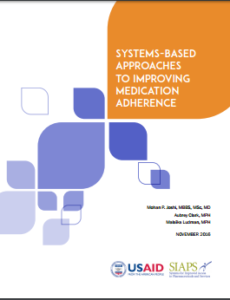By Aubrey Clark, SIAPS Technical Advisor, and Mohan P. Joshi, SIAPS Principal Technical Advisor and Cluster Lead for Pharmaceutical Services
“Medicines don’t work in patients who don’t take them.” – Former US Surgeon General C. Everett Koop
Today, medicines exist to treat many of the world’s most pressing health threats. Deaths from HIV/AIDS have fallen by 43% since 2003 largely due to the introduction of improved antiretroviral medicines and treatment regimens.[1] Similarly, deaths from TB and malaria have dropped by 22% and 48%, respectively, since 2000 as a result of efforts to improve access to medicines for treatment and prevention.[2],[3] While progress has been uneven in many settings and much work remains to ensure that these trends continue, more people than ever before are getting the lifesaving medicines they need.
But access alone is insufficient to improve health. Only when medicines are available, accessible, and used appropriately do health outcomes improve. As former US Surgeon General C. Everett Koop noted, “Medicines don’t work in patients who don’t take them.” In fact, WHO estimates that 50% of all patients with chronic illness do not take their medicine correctly,[4] which can exacerbate symptoms, increase the risk of death and disability, and lead to drug-resistant infections.
The reasons why patients don’t take medicine as prescribed, often referred to as non-adherence, are varied and complex and may include a combination of personal, behavioral, social, economic, geographic, and health-related factors. The systems through which medicines are provided are often insufficient and fail to support appropriate use even before the medicine reaches the patient.
In many cases, it is the systemic barriers—not a patient’s beliefs or choices—that determine whether medication adherence is possible. When the price of a medicine is too high, when the local pharmacy is stocked out or too far away, when health professionals fail to address patient concerns and questions, and when patients receive complex or conflicting information from different providers, remaining adherent to treatment simply isn’t a choice. In these and many other ways, health systems can inhibit or enable improved medication adherence.

The USAID-funded SIAPS Program is working to strengthen the systems through which medicines are provided and create an enabling environment for medication adherence. Our new publication, Systems-Based Approaches to Improving Medication Adherence, provides a rationale for looking at adherence through a systems strengthening lens and describes multiple strategies and tools to support better adherence, particularly in resource-limited settings.
The document puts forth a framework that recognizes that multidisciplinary and multilevel approaches and interventions are necessary to strengthen systems for better adherence. Each chapter focuses on a different level of the health system (macro, meso, and micro) and suggests key interventions that relate to the core functions of the health system. This document is relevant for a wide variety of health care actors, particularly policy makers, program managers, government stakeholders, implementing partners, donors, and health managers involved in improving medication adherence.
When health systems can better support patients in seeking and maintaining treatment, not only will medicine use be optimized, but also the full potential of the public health benefit of today’s advances in health and medicine will be realized.
[1] Global AIDS Update. UNAIDS. 2016
[2] Global Tuberculosis Report 2016. World Health Organization. 2016.
[3] World Malaria Report 2015. World Health Organization. 2015.
[4] Adherence to Long-Term Therapies: Evidence for Action. World Health Organization; 2003.

